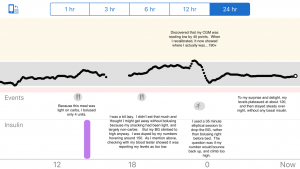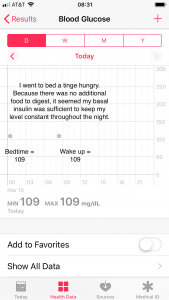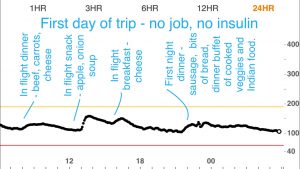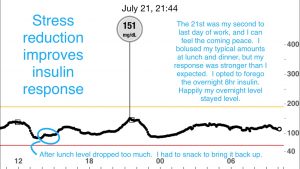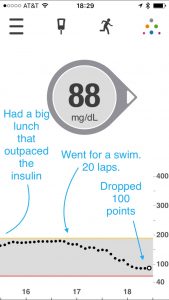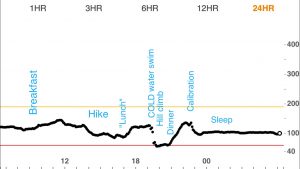I waited too long to order new replacement sensors for my Dexcom G6 CGM (Continuous Glucose Monitor), so when I finally did, it took half a week to get re-authorized with my insurance. Then the order appeared to have fallen into the cracks. My prompt to inquire into status came after another half week. It will take time to ship. In the end, I’ll be without sensors and CGM data for several days, maybe a week or more.
Ironically, as I relaunch my blog posting practice, I don’t have any real-time data nor screen shots to share until my sensors arrive. So I’m back working “old school”, with finger pricks and only a handful of data points per day.
So today was a bit of a surprise. I woke just north of 100, did some stretching and a half hour of meditation, then made breakfast and lunches for the kids, sent them off, and came back home to do the elliptical for half an hour before starting my day. I expected that would have dropped my blood glucose from however high it climbed after breakfast without bolusing, and would then stay reasonably level until lunch.
When I sat down to lunch at noon, I tested before bolusing for lunch, and found that I was at 180! Ah, how I long for the minute-by-minute insights of my personal CGM. I gave myself a slightly larger dose of six units before eating a vegetarian mediterranean plate of hummus, falafel, salad, etc. (These days my standard bolus is 5 units of Humalog for a regular meal. Hummus, falafel and such are pretty “carby” so I expected them to challenge the system a bit more than a non-carry meal. On top of that, I was starting at 180, so that seemed like a tall order for 5 units.) When I checked again after a light bike ride this afternoon right before dinner, I was back down to 95. The 6 units seemed to have done the trick without causing a crash.
What surprised me was the climb to 180 after breakfast up until lunch time. That was a longer peak than I would have thought. Even though I planned to exercise in the morning, perhaps I should have bolused before or shortly after breakfast? I’ll have to keep closer tabs on what I eat at breakfast, and once my CGM is back in action, watch to see what’s going on.
